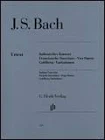Bach, Johann Sebastian : 4 Duette BWV 802-805
Work Overview
Publication Year:1739
First Publisher:chez l'auteur
Instrumentation:Piano Solo
Genre:pieces
Total Playing Time:13 min 00 sec
Copyright:Public Domain
Commentary (1)
Author : Asayama, Natsuko
Last Updated: July 1, 2007
[Open]
Author : Asayama, Natsuko
Clavier-Übung Part III. Consisting of various preludes for the organ, based on the catechism hymns and other hymns. For the spiritual recreation of connoisseurs and especially those well-versed in such works. Completed by Johann Sebastian Bach, Royal Polish and Electoral Saxon Court Composer, Kapellmeister, and Director of the Choir in Leipzig. Published by the composer.
The inclusion of four duets in Clavier-Übung Part III, later known as the "German Organ Mass"—a collection of organ chorales of extremely large scale—is a minor mystery given the religious significance of the work, and has been debated through various speculations and theories. The collection was published in 1739, the year of the 200th anniversary of the Reformation in Leipzig. The cantus firmus of the chorales were chosen from those central to the Mass and the Lutheran catechism: Kyrie, Gloria, the Ten Commandments, the Creed, the Lord's Prayer, Baptism, Penitence, and Holy Communion. The entire collection comprises 21 pieces, a number derived from multiplying '3' (symbolizing the Trinity) by '7' (symbolizing God's grace or the seven days of creation). Furthermore, the Prelude and Fugue placed at the beginning and end of the collection are in E-flat minor, possessing three flats, also symbolizing the Trinity. Why then do four duets appear here? Theories include: 'representing the four elements of earth, water, wind, and fire' (R. Steglich)—though it is unclear which corresponds to what—; 'mistakenly included during publication' (A. Schweitzer); 'included more general clavier works out of concern for sales of the published score' (H. Keller), and so on. The truth can no longer be ascertained. Currently, as Keller also states, it is thought that Bach hastily added these for amateurs so as not to betray the wording in the preface.
Due to the works consisting entirely of two voices, their apparent sudden addition to the collection, and the lack of discernible religious connections or symbolism, the four duets have been regarded as works for clavier rather than organ since the 19th century, and were excluded from the organ works section in Schmieder's Bach-Werke-Verzeichnis (BWV). Consequently, while the Prelude and Fugue are assigned BWV 552 and the organ chorales are in the BWV 600s, these four duets are assigned numbers in the BWV 800s.
Incidentally, the inclusion of harpsichord pieces in a collection of organ chorale works does not, on the other hand, preclude the possibility of playing the non-pedal pieces of Clavier-Übung Part III, the so-called 'Little Catechism,' on the harpsichord. While D. Schulenberg states that it cannot be said that all non-pedal chorale arrangements are for harpsichord, and that they were rather written for organs without pedals or for organists with undeveloped pedal technique, he points out that 'Allein Gott in der Höh sei Ehr' (BWV 677), 'Dies sind die heil'gen zehn Gebot' (BWV 678), and 'Wir glauben all an einen Gott' (BWV 681) contain more harpsichord-like idioms compared to other pieces.
1. E minor / BWV 802
Begins with a toccata-like theme containing chromaticism. For Bach, E minor seems to have been the key closest to chromatic sonorities. The Toccata (BWV 914), the Fugue from The Well-Tempered Clavier Book I (BWV 855), the 'Crucifixus' from the Mass in B minor, and the Organ Fugue (BWV 548) are also written in E minor.
2. F major / BWV 803
Adopts a clear ABA, or da capo, form. The theme of the first half combines triads with crisp rhythms and stepwise motion, while the middle section presents a completely contrasting theme with irregular rhythms including an augmented second.
3. G major / BWV 804
The only one of the four pieces that contains almost no chromatic elements, unfolding instead in a consistently bright and clear sonority. However, the thematic development is extremely meticulous, with expansion of motives and splendid linkages observed in the latter half.
4. A minor / BWV 805
Features a long theme exceeding nine measures. The undulating eighth notes in the latter half of this theme appear with various modifications as counter-phrases or interjections, creating a sense of chiaroscuro.






